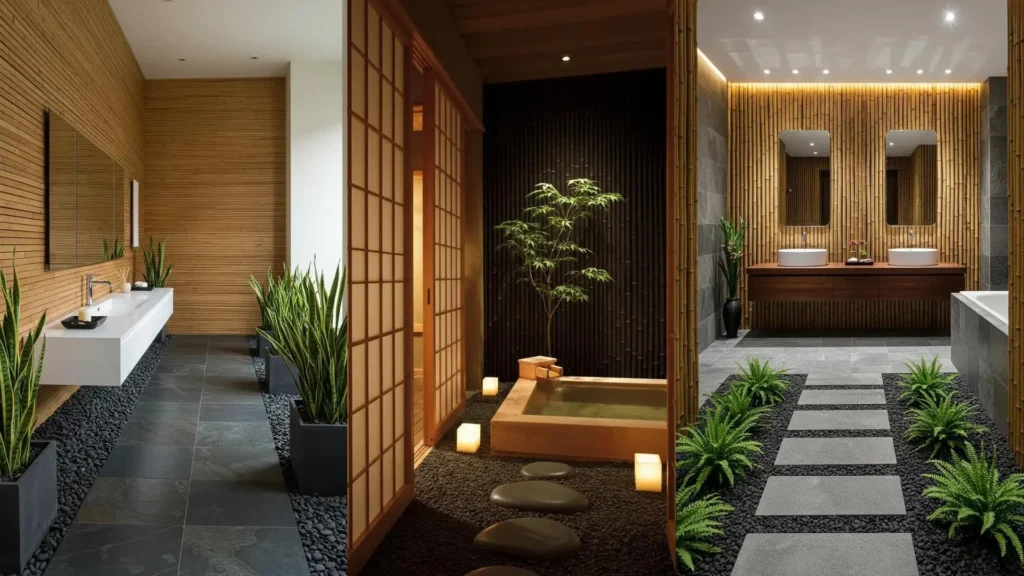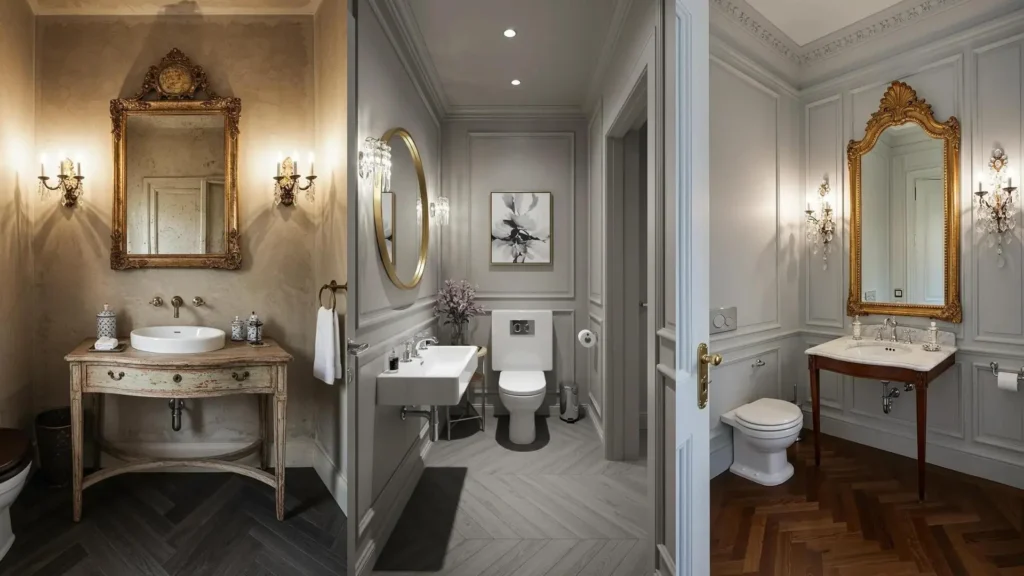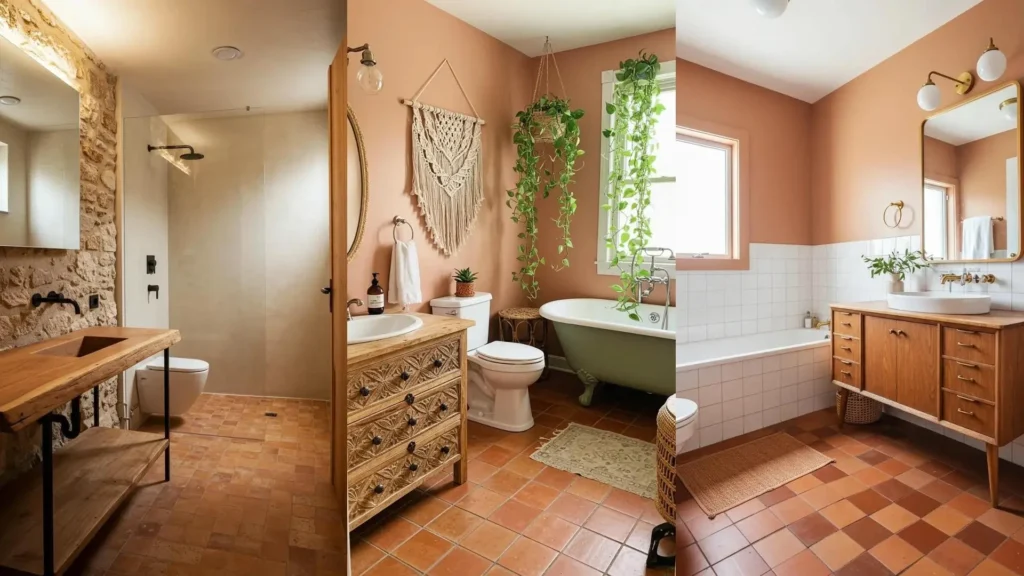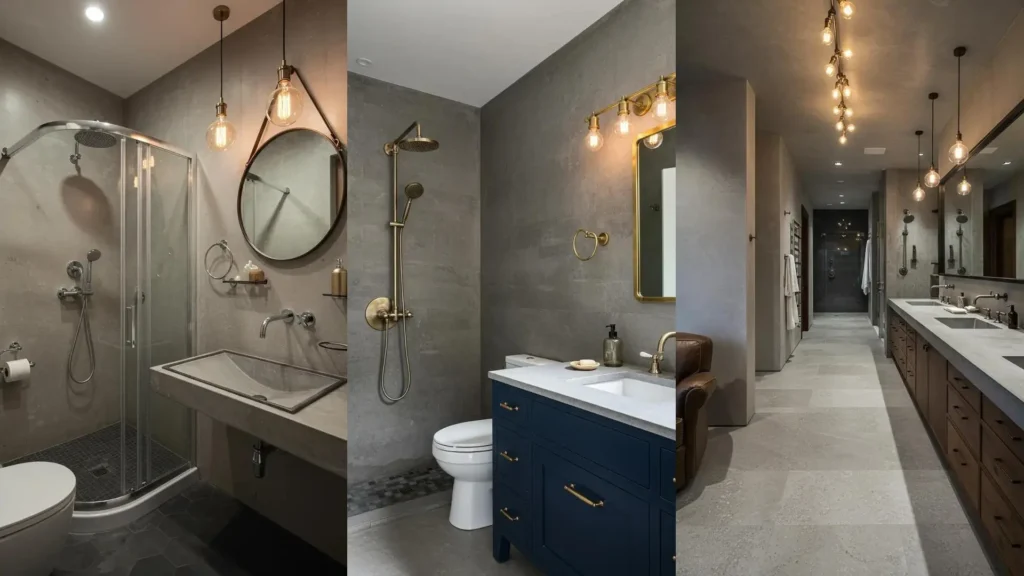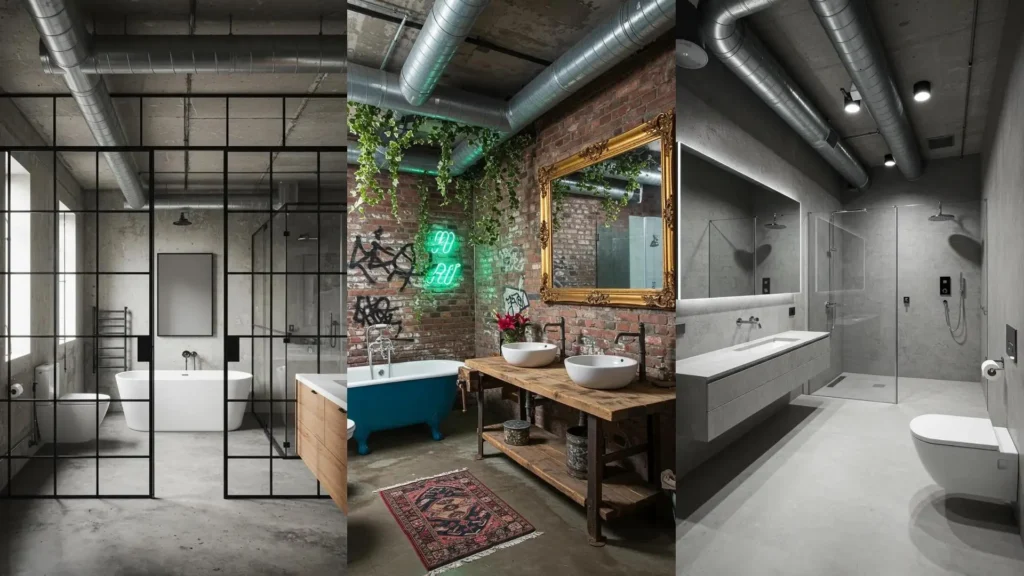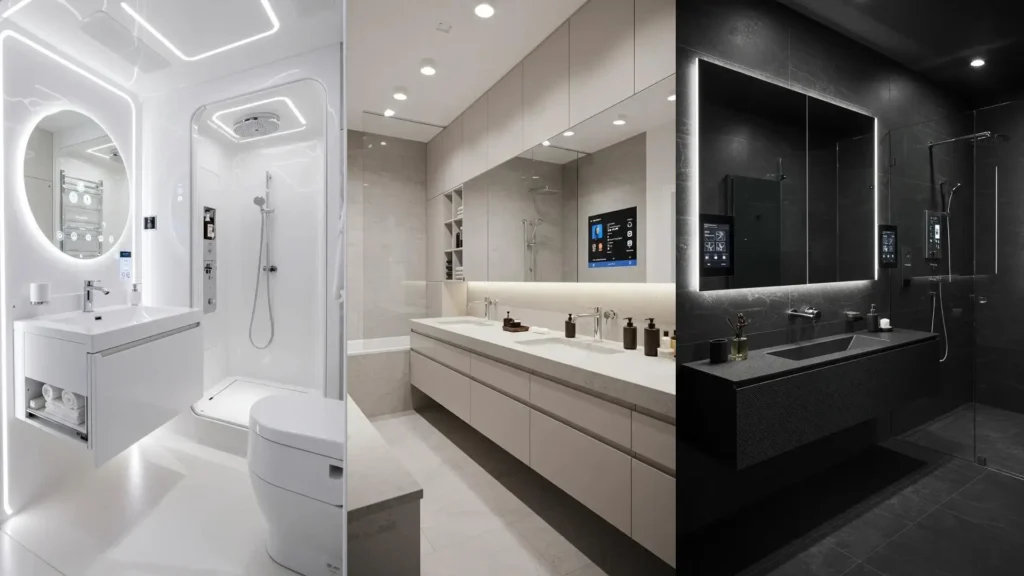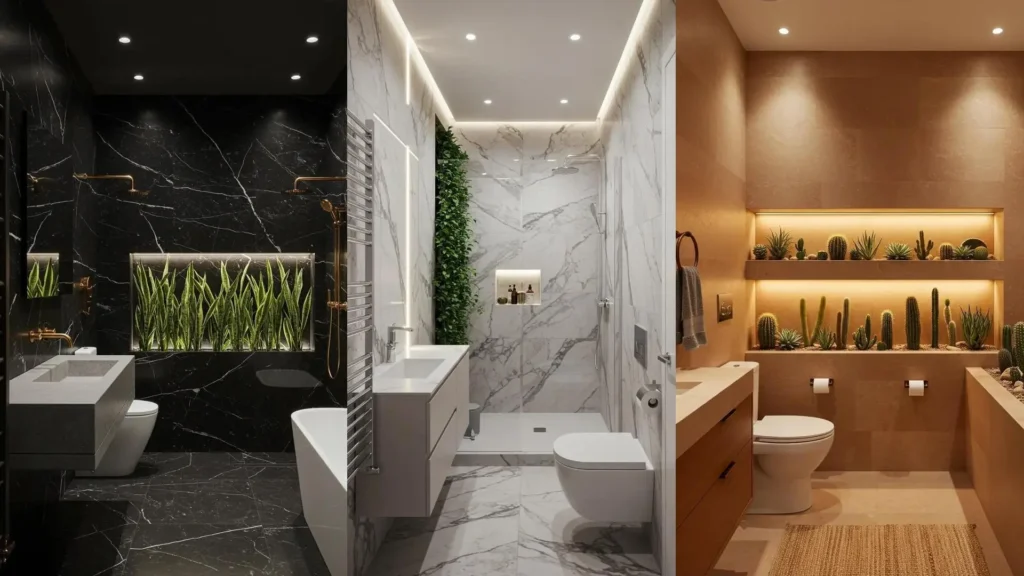Your bathroom should be more than just a functional room; it should be your personal sanctuary—a place to wash away the day and reconnect with yourself.
By thoughtfully incorporating natural elements, you can transform this space into a Zen-inspired retreat. It’s not about a complete overhaul. It’s about making intentional choices with texture, light, and life.
Here, you’ll discover how to use bamboo, stone, and plants to create a bathroom that feels grounding, calming, and deeply restorative. Let’s create a space that truly nurtures you.
1. Define Your Path
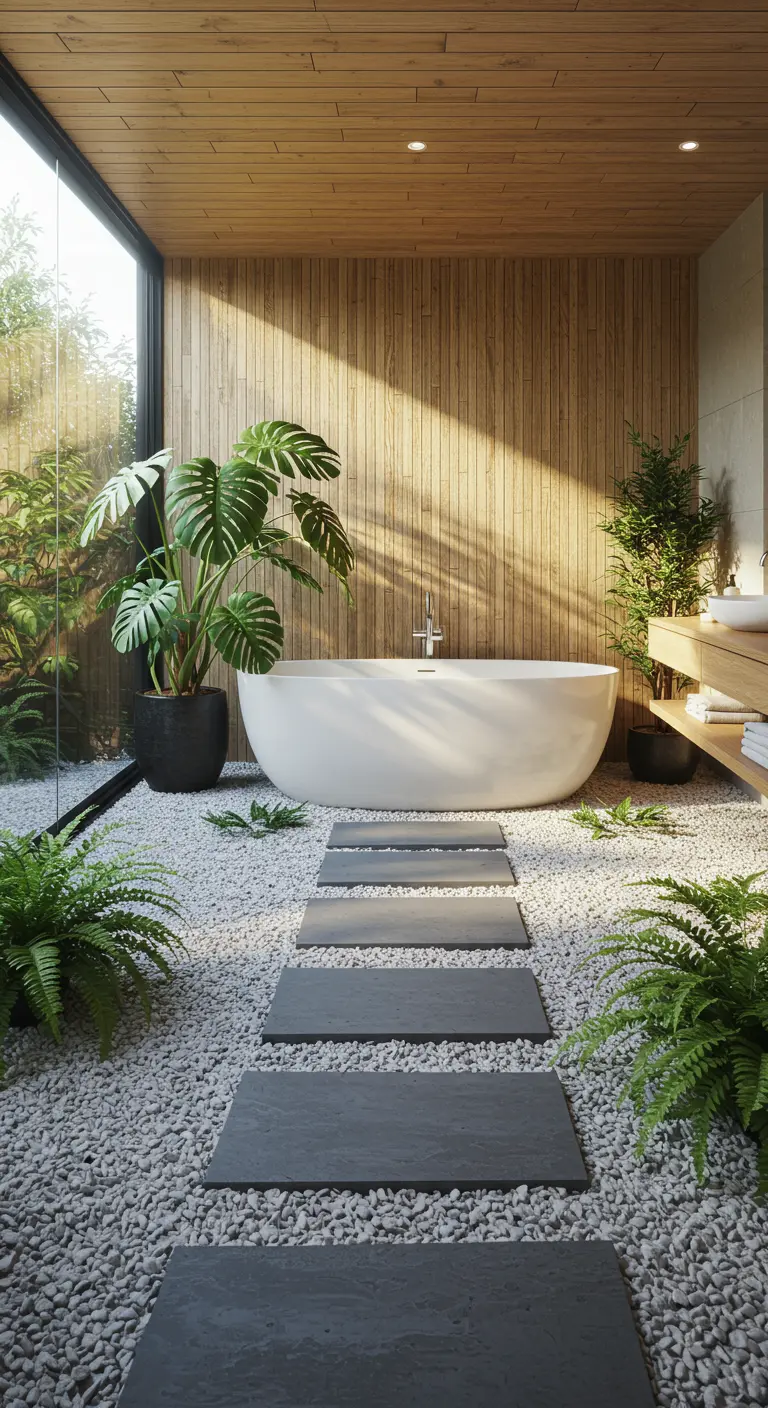
Establish a clear route through the space with large, simple slate pavers.
This grounds the room and creates a mindful journey from the door to the tub, separating the functional path from the softer, decorative pebble bed.
Notice how the warm wood ceiling and slatted wall prevent the stone and glass from feeling cold, creating a perfect balance of textures.
To bring this home, you don’t need to replace your entire floor. You can create a contained pebble area with a raised wooden frame, achieving a similar effect without a full renovation.
2. Embrace Monochromatic Depth
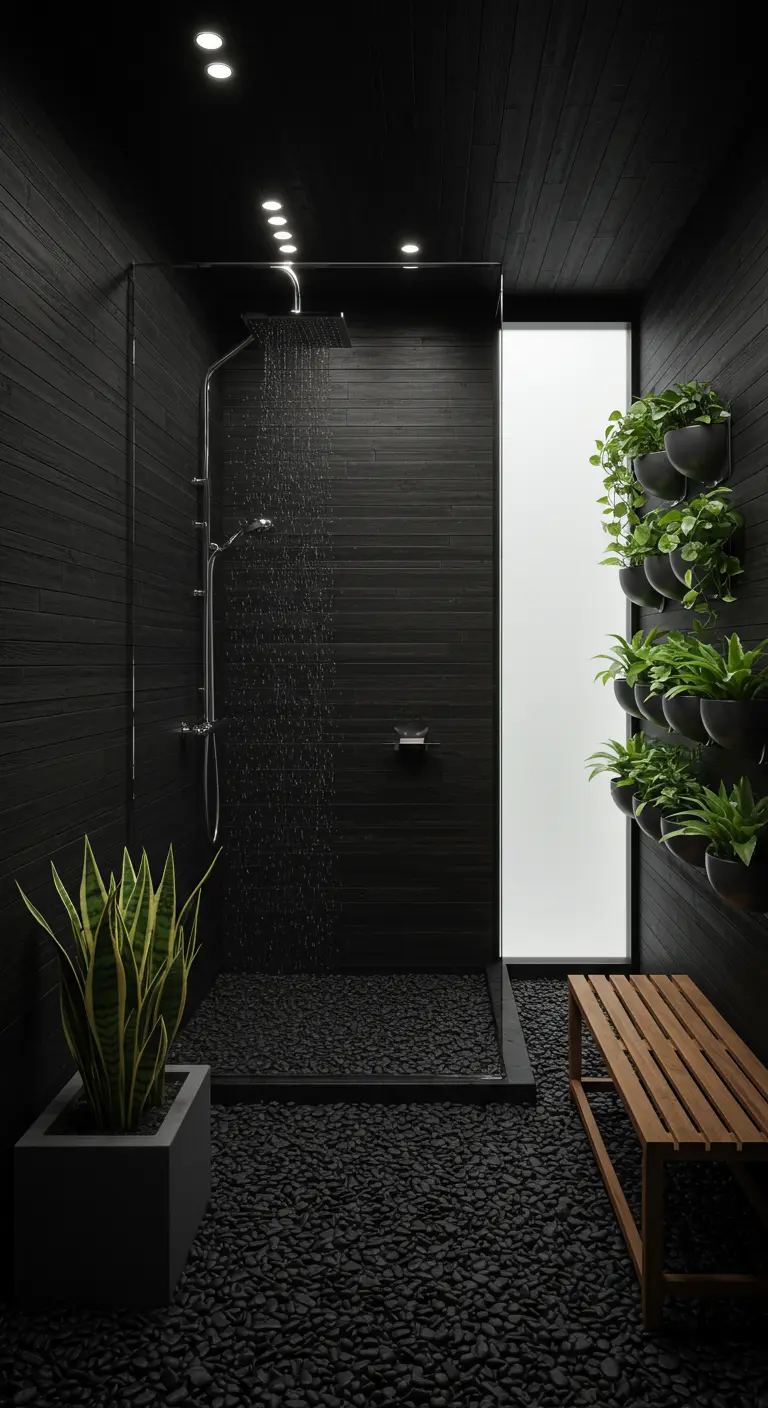
A dark, unified palette can feel incredibly serene, not confining.
Here, black slatted walls, a black pebble shower floor, and dark fixtures create a continuous, calming envelope.
The key to making this work is texture and light. The slats add rhythm, the pebbles offer a tactile quality, and the vertical frosted window provides diffuse, soft light that prevents the space from feeling flat.
A vertical wall planter introduces life and breaks up the dark surface without interrupting the clean lines. This is a powerful strategy for adding greenery in a narrow space.
3. Elevate a Single Sculptural Element
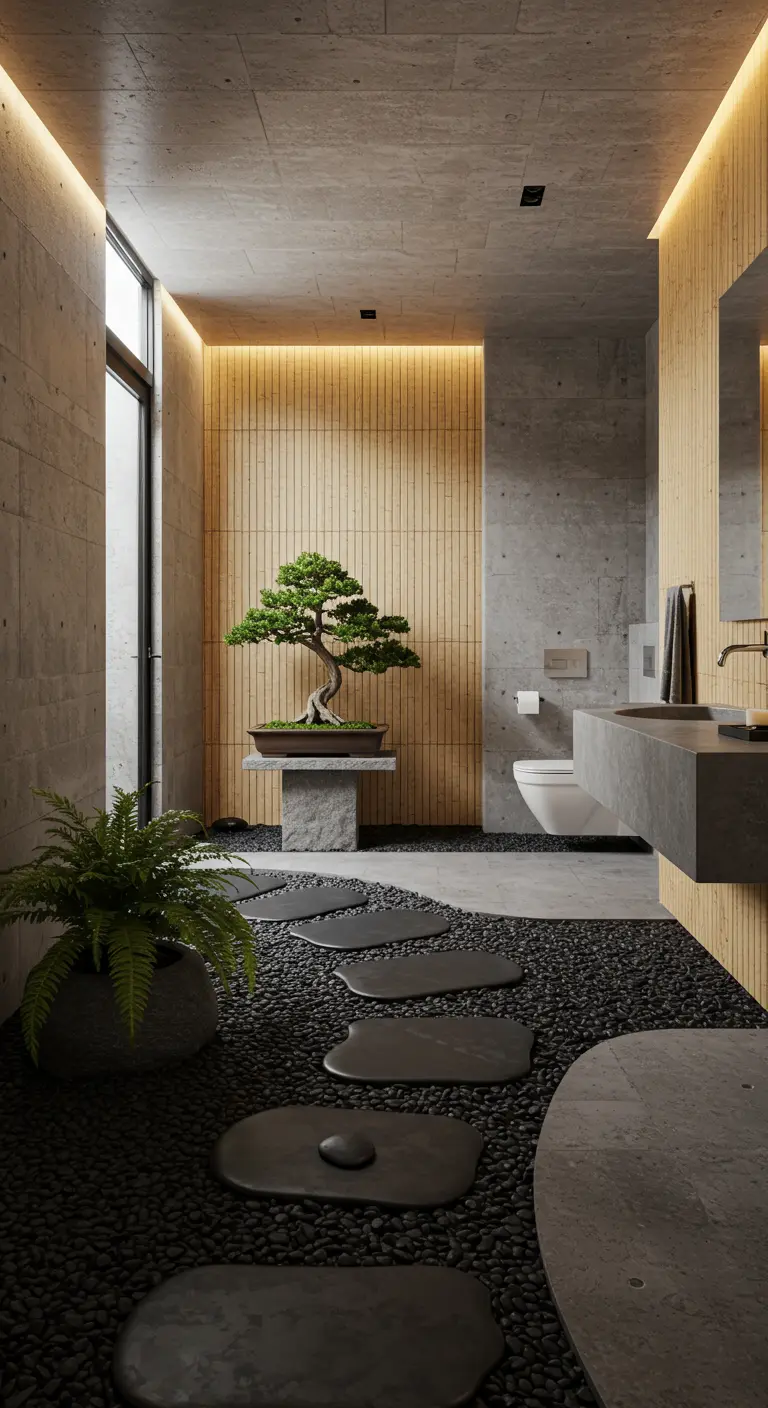
Your bathroom doesn’t need to be filled with plants to feel like a garden.
Instead, choose one magnificent specimen, like a bonsai tree, and treat it like a work of art. Placing it on a simple stone pedestal gives it importance and draws the eye.
Combine raw concrete walls with a warm, backlit bamboo accent wall. The contrast is sophisticated and intentional.
This approach proves that thoughtful restraint can have more impact than an abundance of decor. It’s about celebrating form and texture. This same principle of singular focus works well in other rooms, especially for a tiny entryway.
4. Cultivate Atmosphere with Moody Lighting
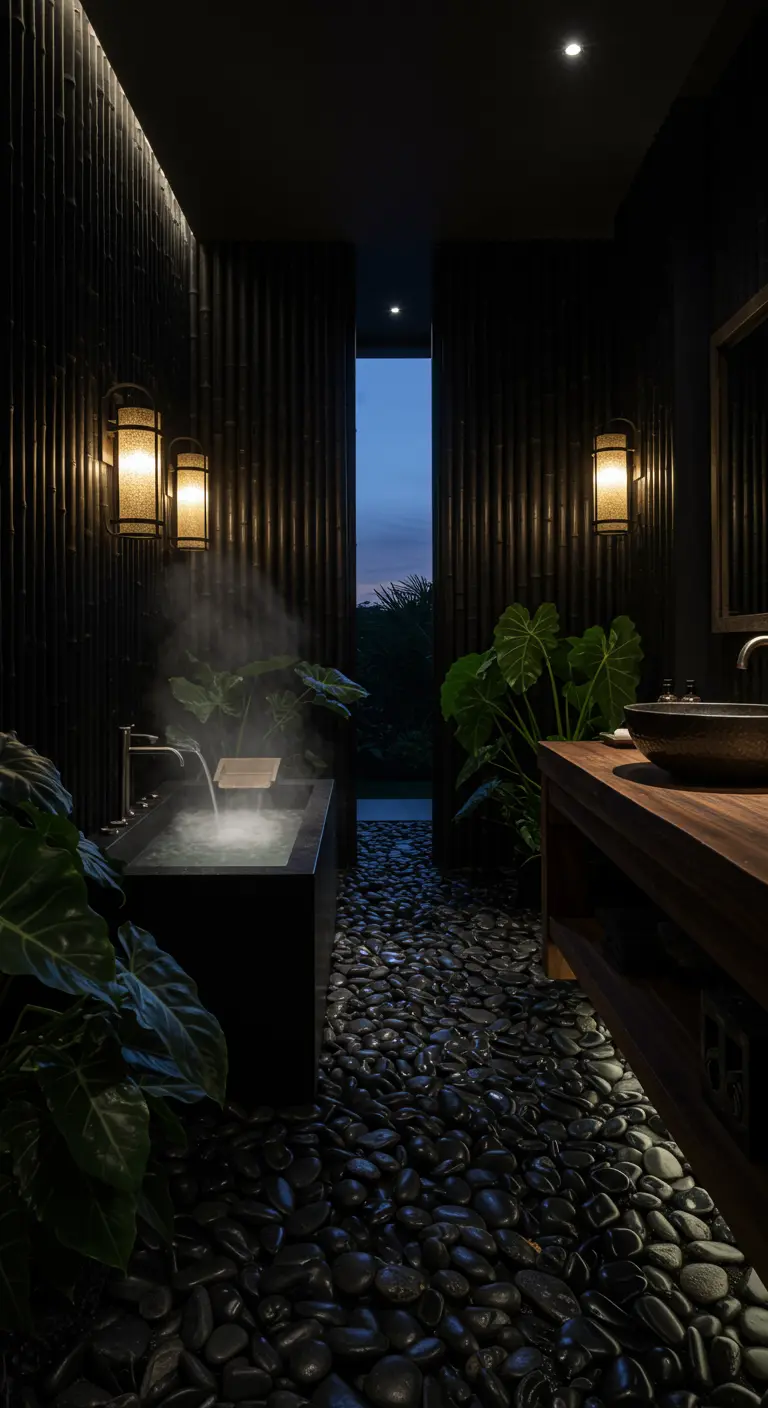
Design for the evening retreat you deserve.
Dark bamboo walls and a floor of polished black river stones absorb light, creating an intimate, enveloping mood.
Instead of harsh overhead lighting, use warm, low-level wall sconces to cast a gentle glow. This technique, called light layering, is essential for creating atmosphere.
The steam from the tub catches the light, adding a dynamic, ethereal quality to the space. It’s a reminder that a room’s feel changes throughout the day.
5. Erase the Boundary Between Inside and Out

If you have an adjacent courtyard or private outdoor space, this is the ultimate goal.
Use folding glass doors to completely open the bathroom to a private garden. The flooring continues visually, with a stone path leading from the interior wood floor across a bed of moss and ferns.
The key is material continuity. The bamboo wall outside mirrors the warmth of the wood inside, making the two spaces feel like one cohesive unit.
This idea of creating an outdoor room is also perfect for patios and terraces.
6. Harness the Power of Overhead Light
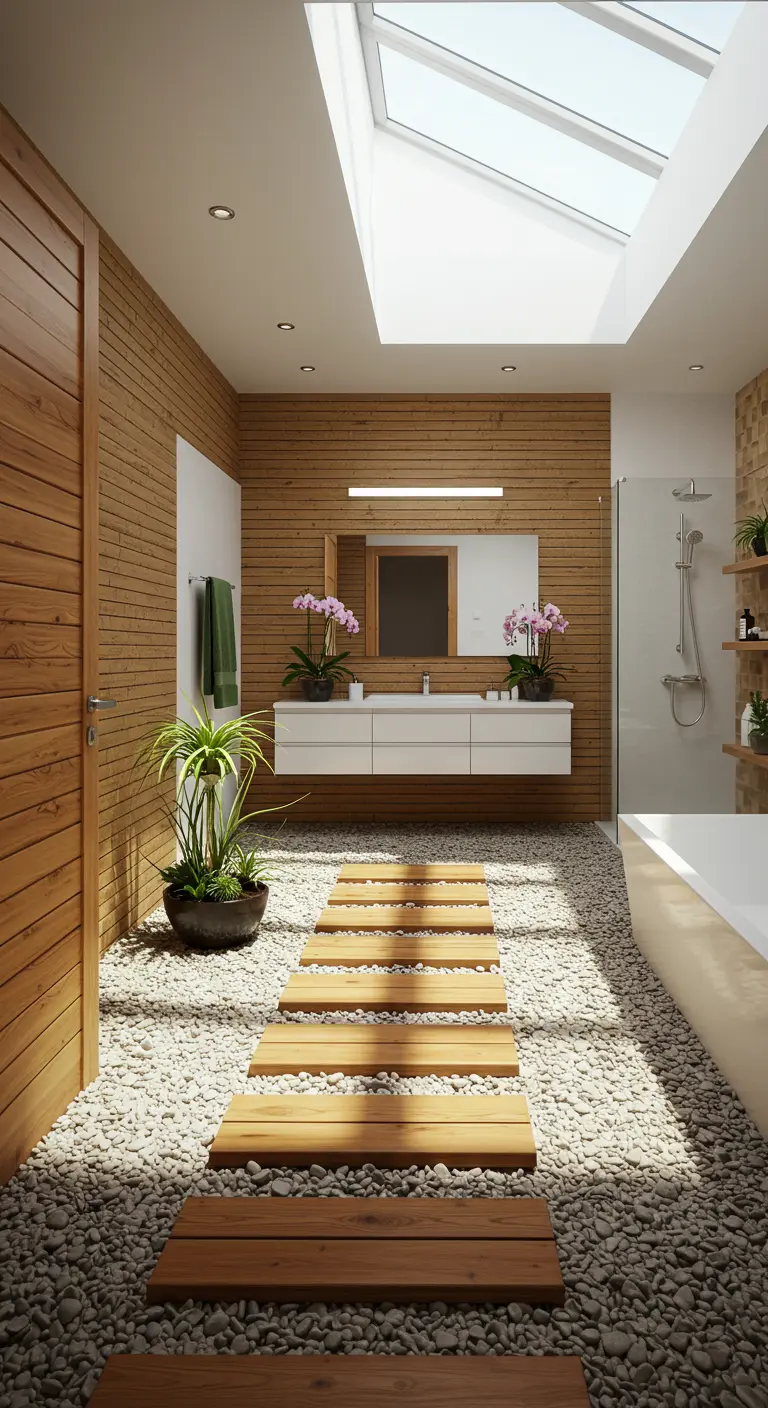
A skylight is a game-changer, especially in a bathroom where privacy is a concern.
It floods the space with natural light, making the plants thrive and highlighting the textures of the stone floor and wood-plank path.
Positioning the vanity lighting directly above the mirror provides clear, functional light for daily routines without interfering with the room’s ambient glow.
If a skylight isn’t an option, mimic the effect with a large, flush-mounted LED panel with a daylight color temperature (5000K-6500K).
7. Frame Your Vanity with Natural Texture
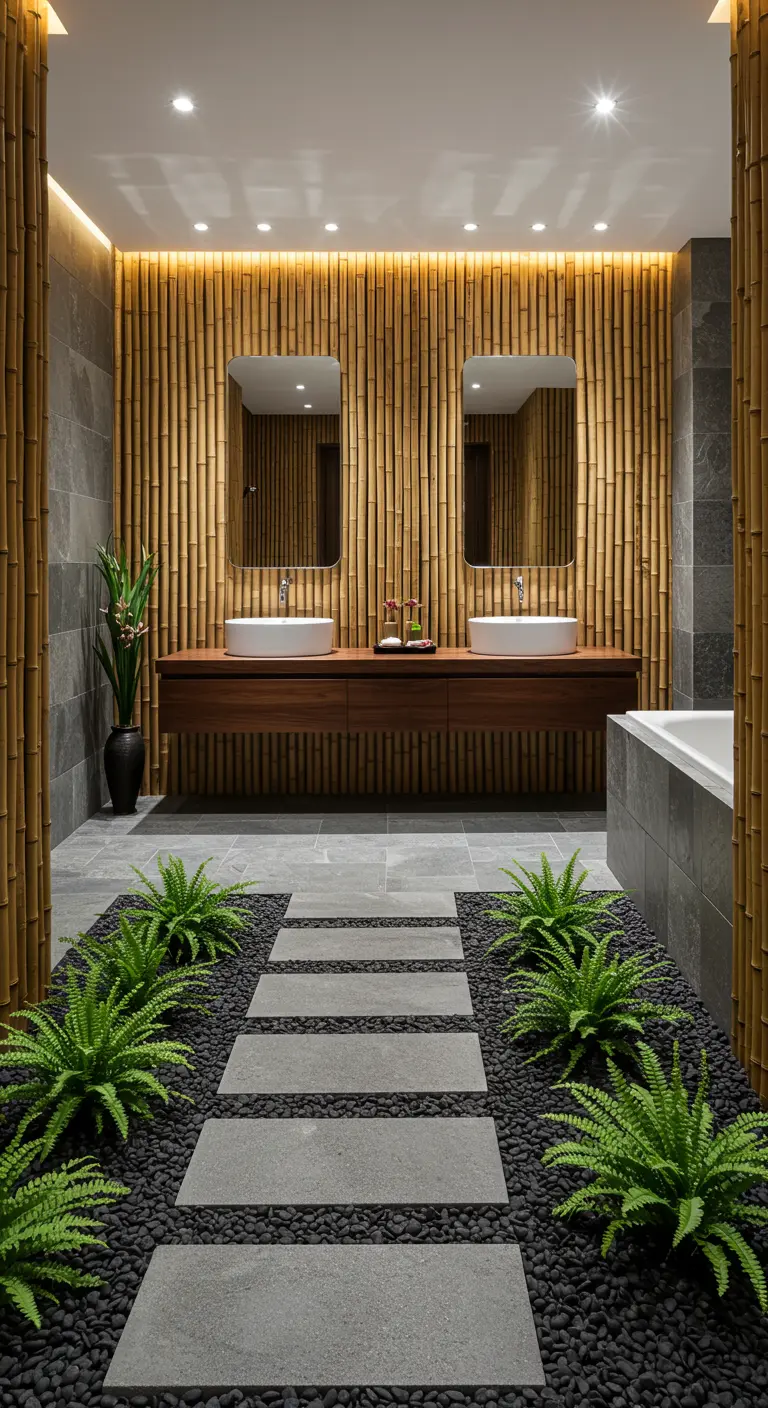
Turn your vanity wall into the room’s main feature.
Here, a wall of vertical bamboo stalks provides a stunning, organic backdrop for the dual sinks. The texture is rich and complex, yet the overall effect is orderly and calm.
Backlighting the bamboo wall with hidden LED strips adds depth and a warm, welcoming glow, especially in the evening. This makes the wall feel intentional, not just decorative.
Pairing this natural element with sleek, modern sinks and mirrors creates a beautiful tension between rustic and refined. You can create similar hybrid looks in other spaces, too.
8. Create a Meditative Corner with Shoji and Ofuro
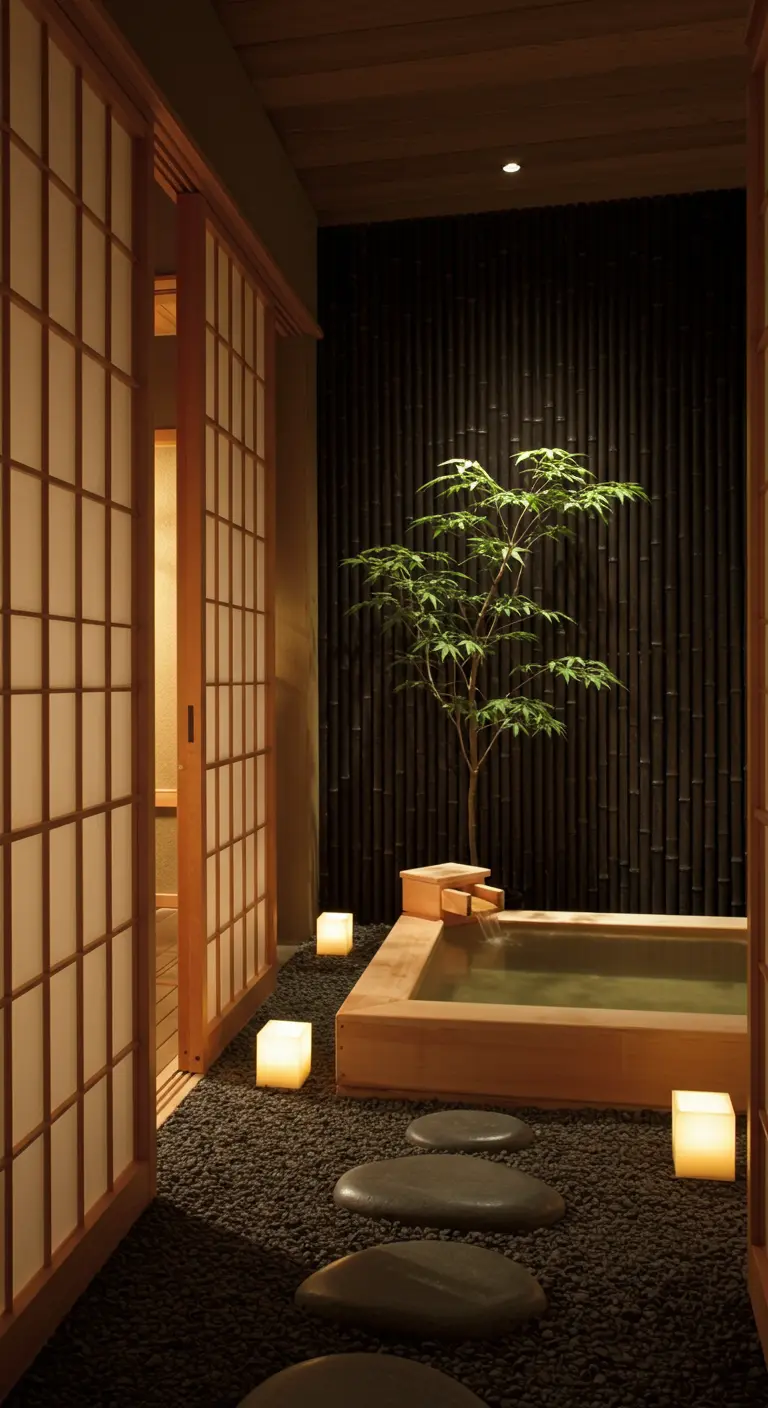
Incorporate traditional Japanese design elements for an authentic sense of peace.
A wooden soaking tub, or *ofuro*, encourages mindful bathing rather than a quick shower. Shoji-style sliding screens provide privacy while allowing soft, diffused light to pass through.
Instead of bright overhead lights, place simple, glowing floor lanterns along the path. This keeps the light source low and indirect, fostering a deeply relaxing environment perfect for unwinding.
This approach to creating cozy corners works wonders in any room that needs a quiet zone.
9. Introduce the Element of Sound with Water
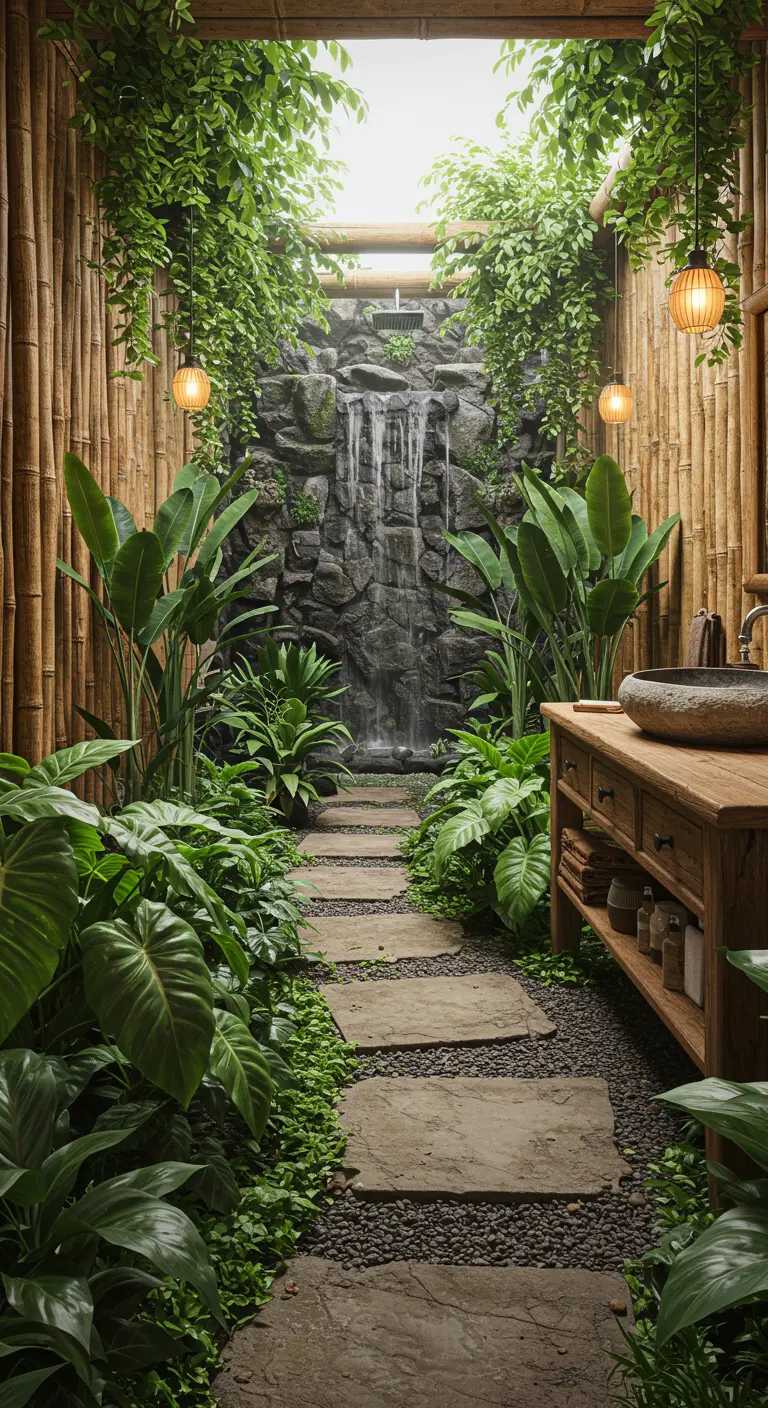
A Zen garden appeals to all senses, not just sight.
A built-in waterfall feature over a stone wall introduces the gentle, soothing sound of moving water, instantly masking outside noise and promoting relaxation.
Surround the feature with lush, humidity-loving plants like bird of paradise and ferns to create a true oasis. The constant moisture from the waterfall will help them thrive.
While a built-in feature is a commitment, you can achieve a similar auditory effect with a smaller, plug-in tabletop fountain placed on a vanity.
10. Play with Paver Shape and Placement
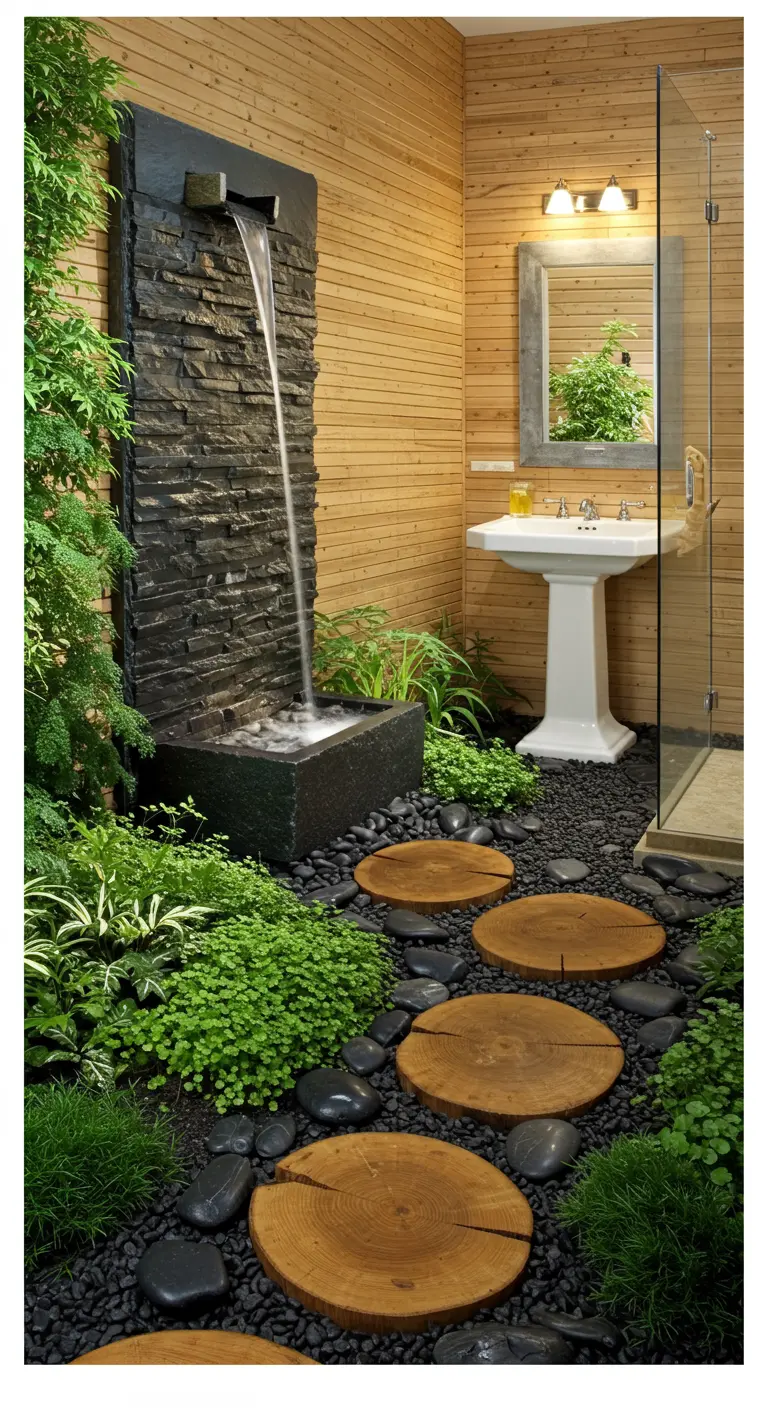
Your path doesn’t have to be straight or use rectangular stones.
Here, round wood slices serve as pavers, creating a more organic, playful walkway. Their warm, natural grain contrasts beautifully with the cool, dark river stones.
The gentle curve of the path encourages you to slow down. It’s a subtle design cue that influences how you experience the space.
This is a wonderful DIY project; you can find wood slices at craft stores or create your own, ensuring they are properly sealed for a humid environment.
11. Think Vertically in Narrow Spaces

Even the smallest powder room can embrace the Zen garden concept.
Use the walls. Here, a vertical bamboo wall treatment adds texture without taking up floor space. Hanging planters draw the eye upward, creating a sense of height and life.
A wall-mounted sink and toilet are essential in a narrow room, as they free up the floor and make the space feel larger and easier to clean.
The stone path continues the garden theme, leading the eye through the space and making it feel longer and more intentional.
12. Mix Concrete, Wood, and Matte Black
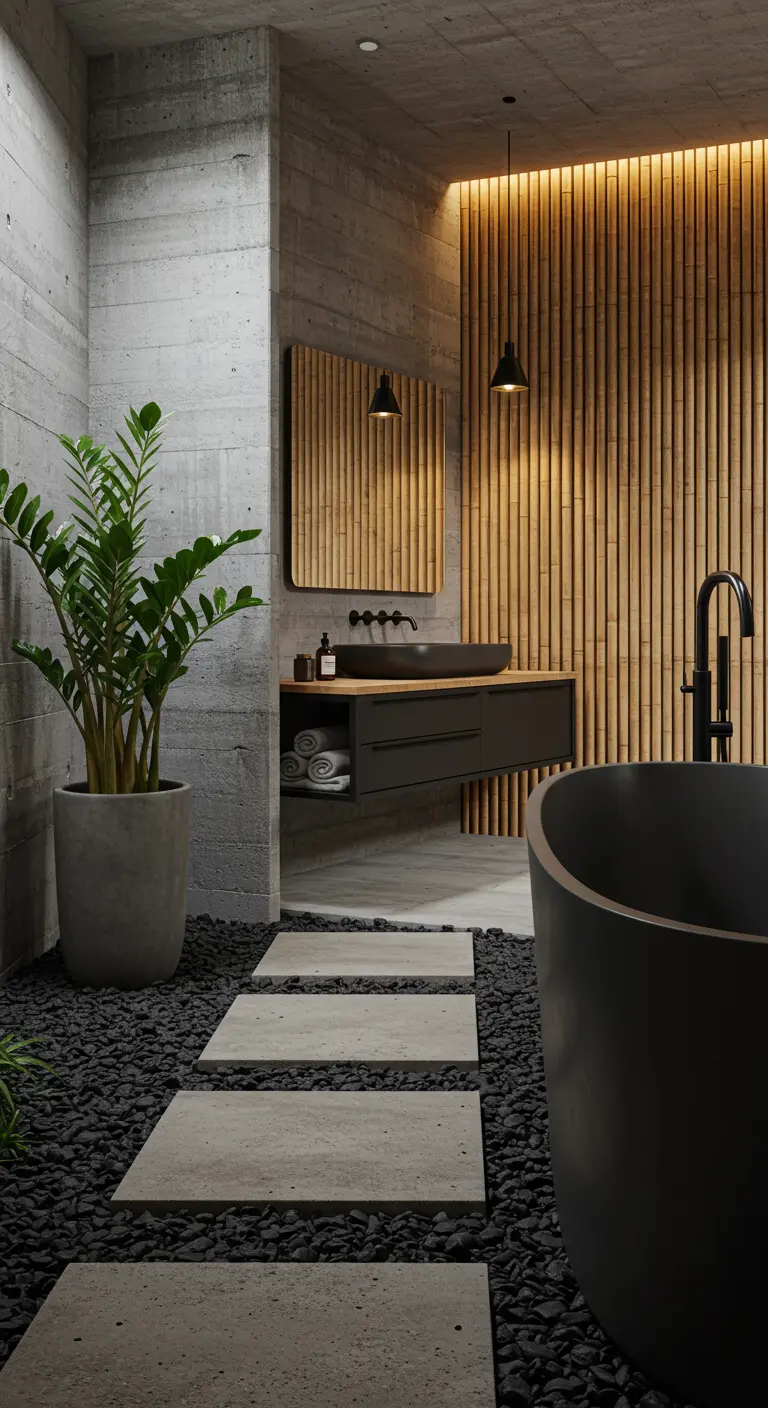
Create a sophisticated, modern sanctuary by balancing industrial and natural materials.
The raw, textured concrete walls provide a cool, minimalist foundation. This is softened by the warm, vertically-slatted wood accent wall, which also cleverly hides ambient lighting.
Matte black fixtures—the tub, faucet, and vanity—add a contemporary edge and anchor the space. The dark color grounds the lighter elements and feels incredibly chic.
This confident mix of textures creates a space that feels both strong and serene, a hallmark of contemporary Zen design.
13. Design a Private Lantern-Lit Grove
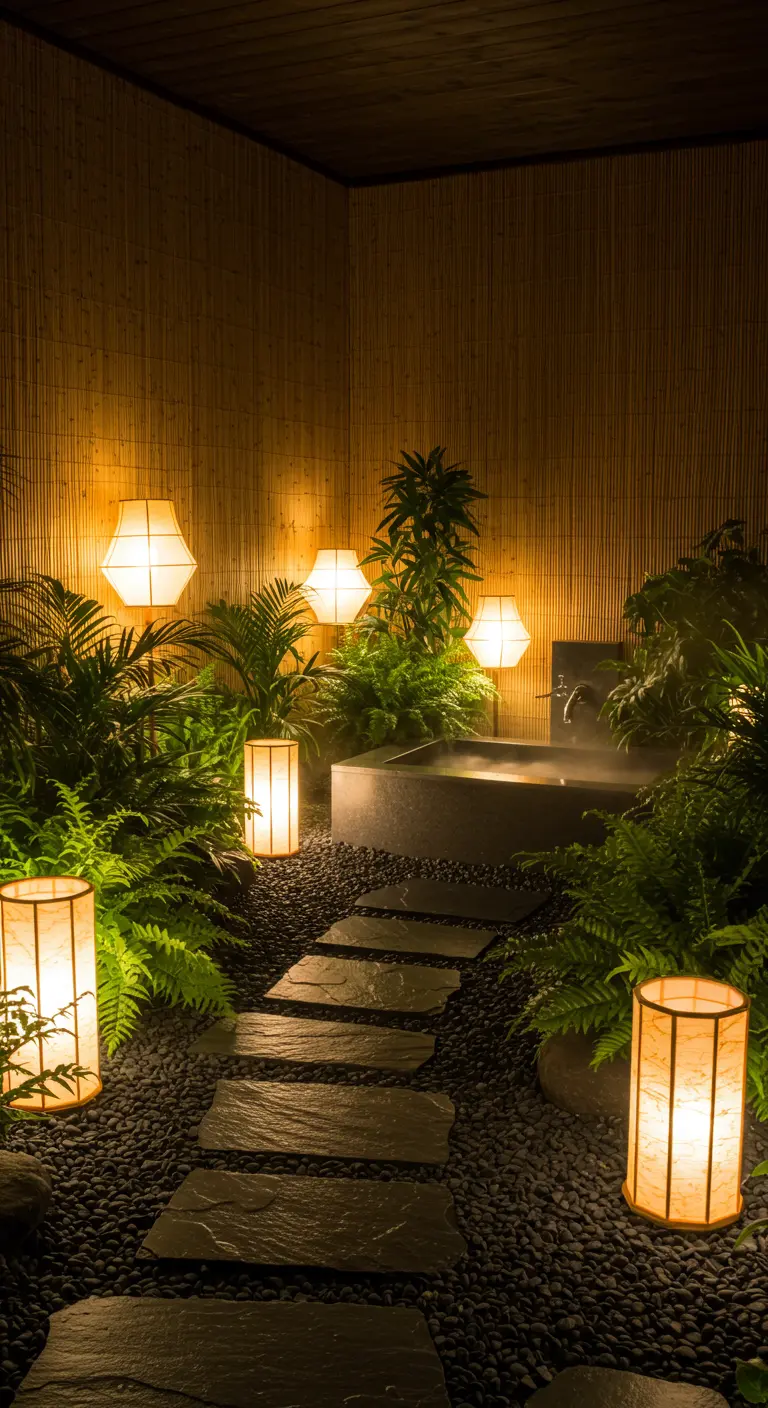
Transform your bathroom into an enchanting evening escape.
Group several paper lanterns of varying heights to create pools of soft, diffused light. This mimics the gentle glow of a traditional Japanese garden at dusk.
Cluster lush ferns around the light sources and the tub. The leaves will create beautiful shadows and silhouettes, adding depth and mystery to the scene.
The key is to keep the lighting warm and low. This intimate setup feels much more special than a single, harsh overhead light. These principles are perfect for romantic evening balconies, too.
14. Soften Corners with Curved Walls
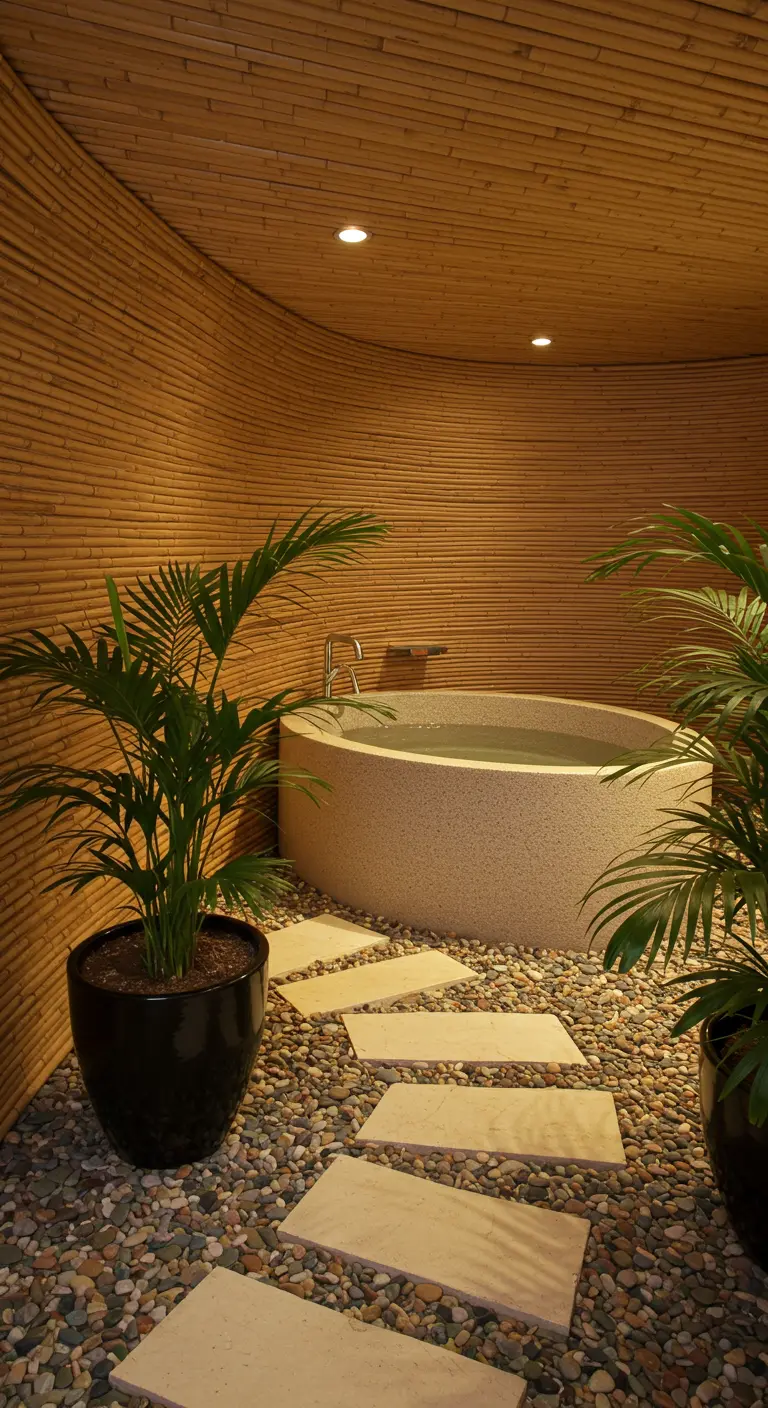
A curved wall can completely change the feeling of a room, guiding movement and creating a cocoon-like sense of enclosure.
Here, a gently curving wall clad in bamboo wraps around the space, making it feel protected and serene. The seamless texture eliminates hard corners, which contributes to the calming effect.
The oval tub echoes the curve of the wall, creating a pleasing harmony of shapes. A simple arrangement of two large parlor palms is all that’s needed to complete this minimalist sanctuary.
15. Create a Contained Riverbed

Bring the garden indoors in a structured, clean way.
Define a central channel in the floor and fill it with a mix of river stones, moss, and low-growing greenery. This creates the illusion of a dry creek bed running through the room.
Frame this feature with warm wood decking on either side to provide a clean, dry surface for walking. This design offers the beauty of a garden without having to walk directly on stones or soil.
This is a brilliant way to introduce a powerful natural element while maintaining a very polished, intentional look.
16. Frame Your Garden with Glass

If you love the idea of an indoor garden but worry about maintenance, this is your solution.
Create a recessed planter bed along one wall and enclose it with a low glass barrier. This keeps soil, moss, and moisture contained while allowing you to enjoy the full visual benefit of the greenery.
It acts like a living diorama within your bathroom. The slate grey floor tiles provide a clean, modern border that makes the green of the ferns and hostas appear even more vibrant.
This design is perfect for separating the ‘wet’ zone of the garden from the ‘dry’ zone of your daily routine.
17. Use High-Contrast Black and White

Zen design doesn’t always have to be soft and muted.
Create a bold, graphic statement by pairing a dramatic black bamboo wall with a crisp white tub and stark white floor tiles. The contrast is striking and modern.
The black pebbles filling the gaps between the white pavers add texture and bridge the two opposing colors. A single, vibrant green fern provides the perfect pop of life against the monochrome backdrop.
This look is confident and clean, perfect for a more minimalist interpretation of the garden theme. The same contrast can be used in modern gothic kitchens for a similar effect.
18. Opt for a Bright, Airy Palette
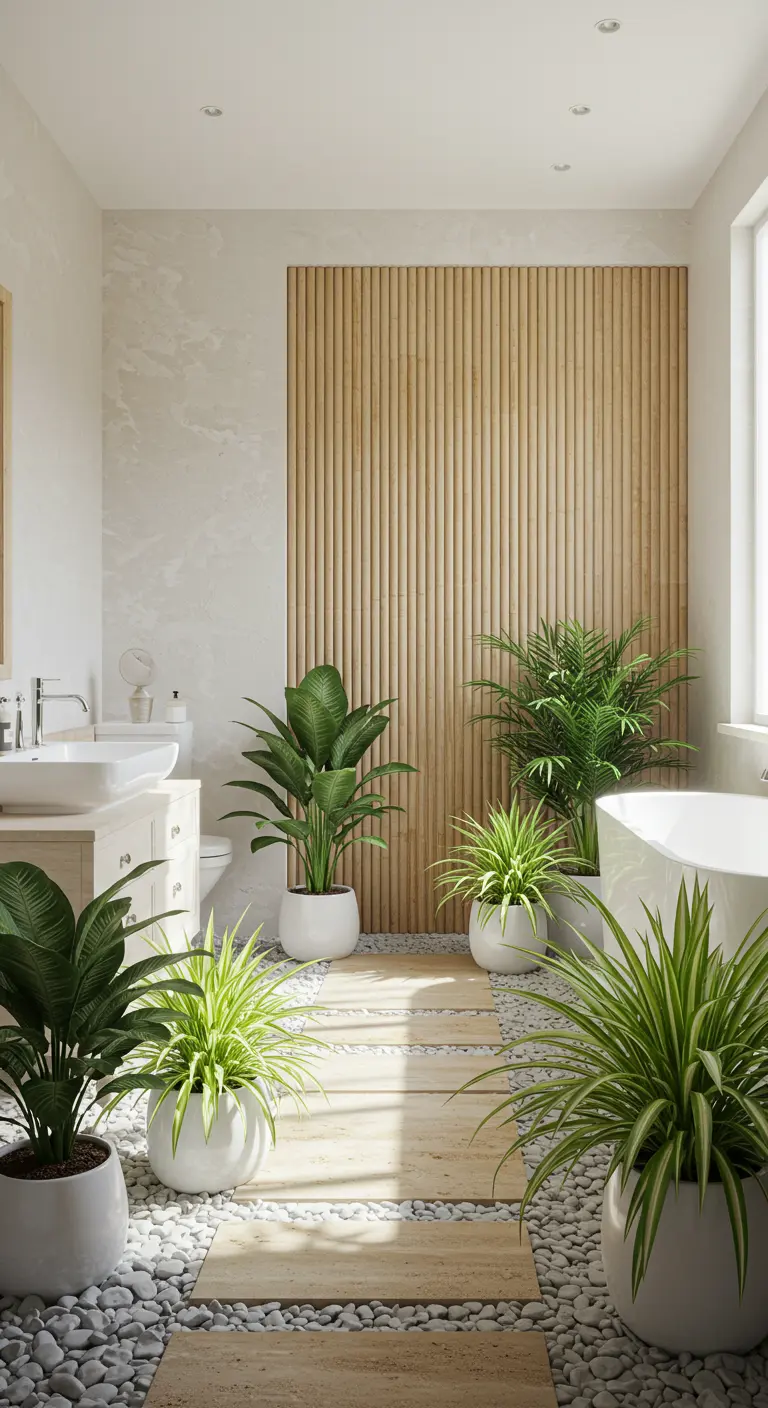
If dark and moody isn’t your style, create a sanctuary that feels light and uplifting.
Use a foundation of creamy white pebbles and light travertine or limestone pavers for the path. Pair this with a light-colored wood slat wall and white planters.
The combination of pale, natural tones and abundant greenery creates a fresh, spa-like atmosphere. It’s calming without being dark.
This palette works exceptionally well in bathrooms with plenty of natural light, making the entire space feel bright and alive, reminiscent of coastal-inspired spaces.
19. Design an Open-Air Shower Experience
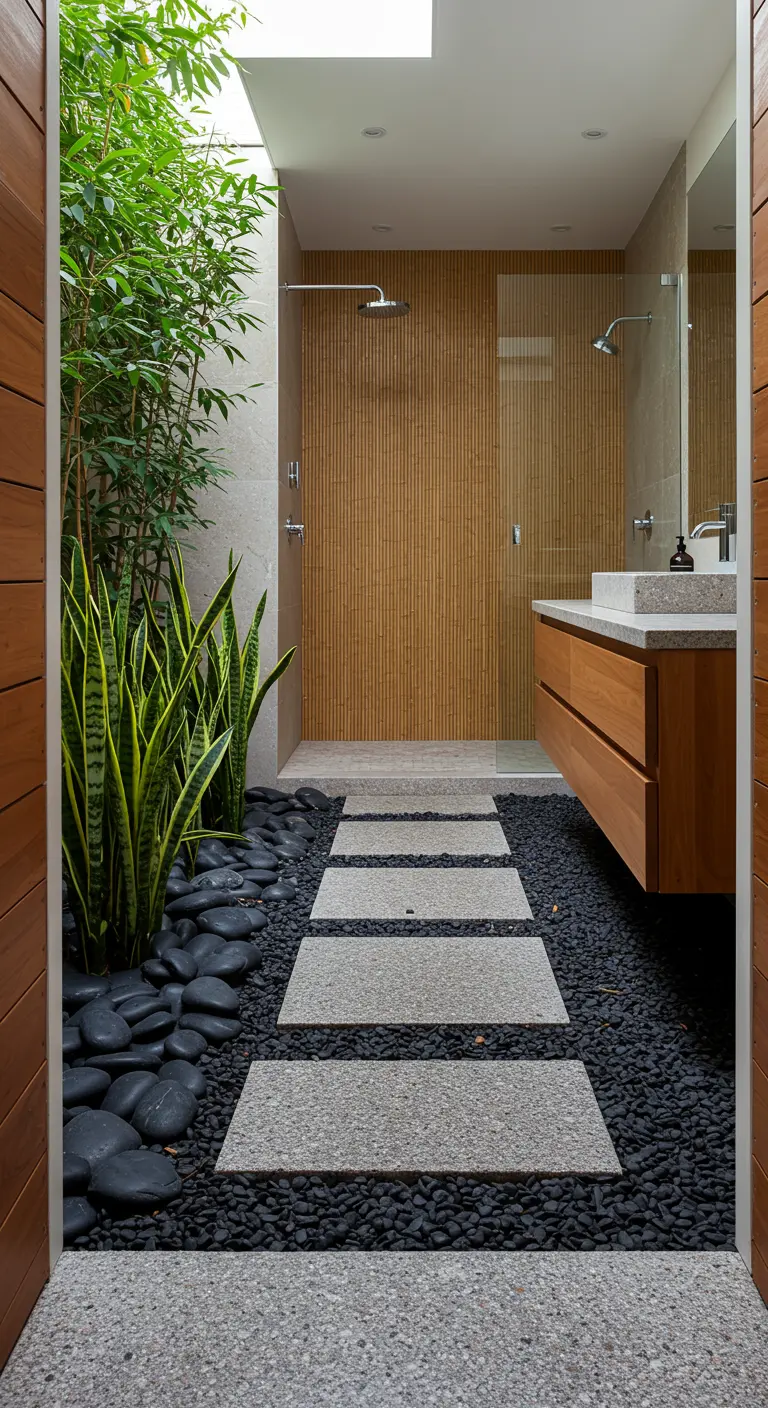
Seamlessly connect your indoor shower with an outdoor garden space.
Here, a partial wall or opening leads from the interior to a private outdoor area. The flooring—a mix of dark river stones and concrete pavers—is consistent throughout, unifying the two zones.
Tall bamboo stalks planted along the edge provide a natural privacy screen that rustles beautifully in the breeze. This design transforms a daily routine into a full sensory experience.
20. Display Plants as Living Wall Art
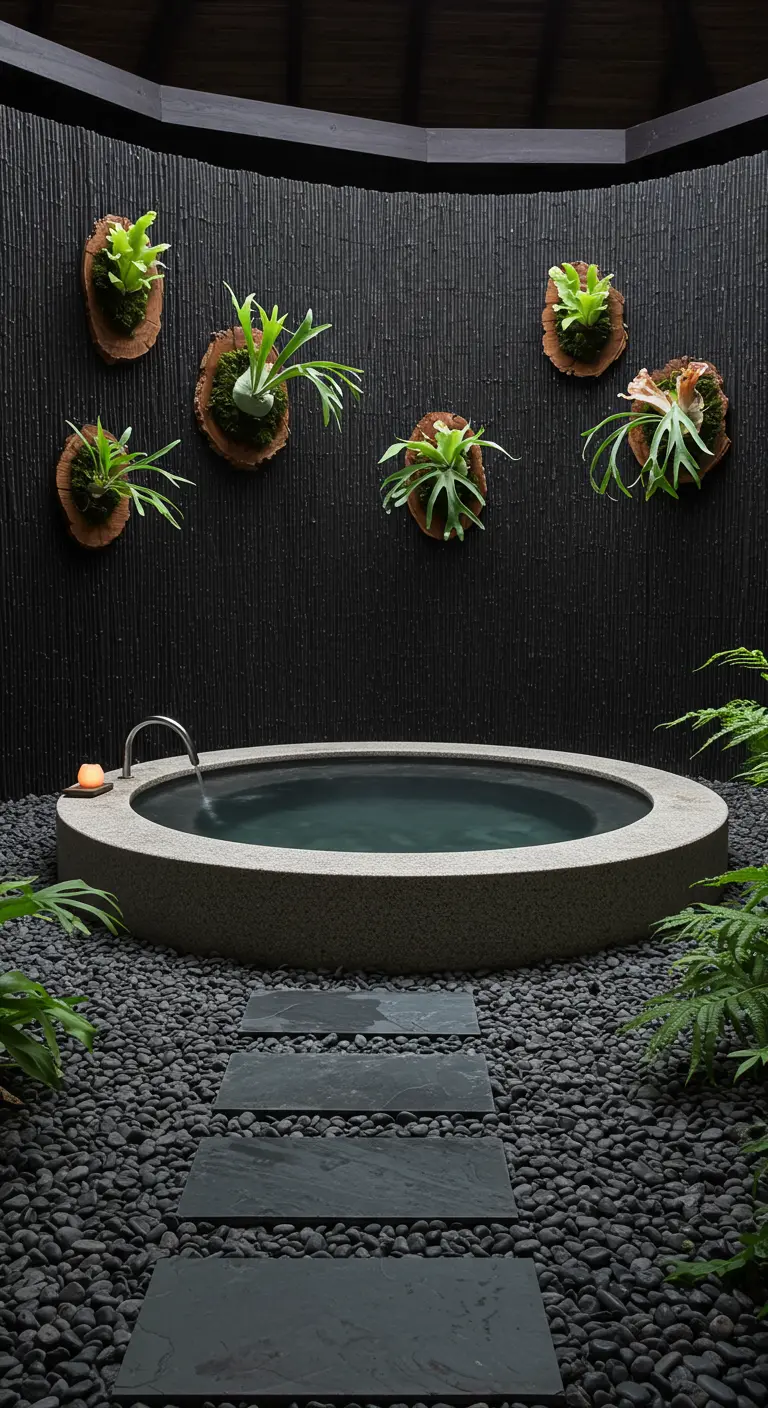
Your plants don’t have to sit on the floor or a counter.
Mounting staghorn ferns on rustic wood plaques turns them into sculptural pieces. Arranged artfully on a dark, textured wall, they become the room’s focal point.
This technique is perfect for adding greenery in a way that feels intentional and curated. It keeps the floor clear and draws attention to the unique forms of the plants themselves.
This is a fantastic solution for renters, as the plaques can be easily hung and removed without permanent changes.
21. Live in a Greenhouse

For the ultimate plant-lover’s bathroom, lean into a greenhouse-inspired design.
An A-frame glass ceiling not only provides incredible light for your plants but also offers a view of the sky and trees, making you feel completely immersed in nature.
The exposed wooden beams add architectural interest and warmth, preventing the glass from feeling too sterile. A simple wooden plank path through a bed of dark gravel keeps the focus on the structure and the surrounding greenery.
This is a commitment, but it creates a truly one-of-a-kind sanctuary.
22. Hang a Kokedama Garden
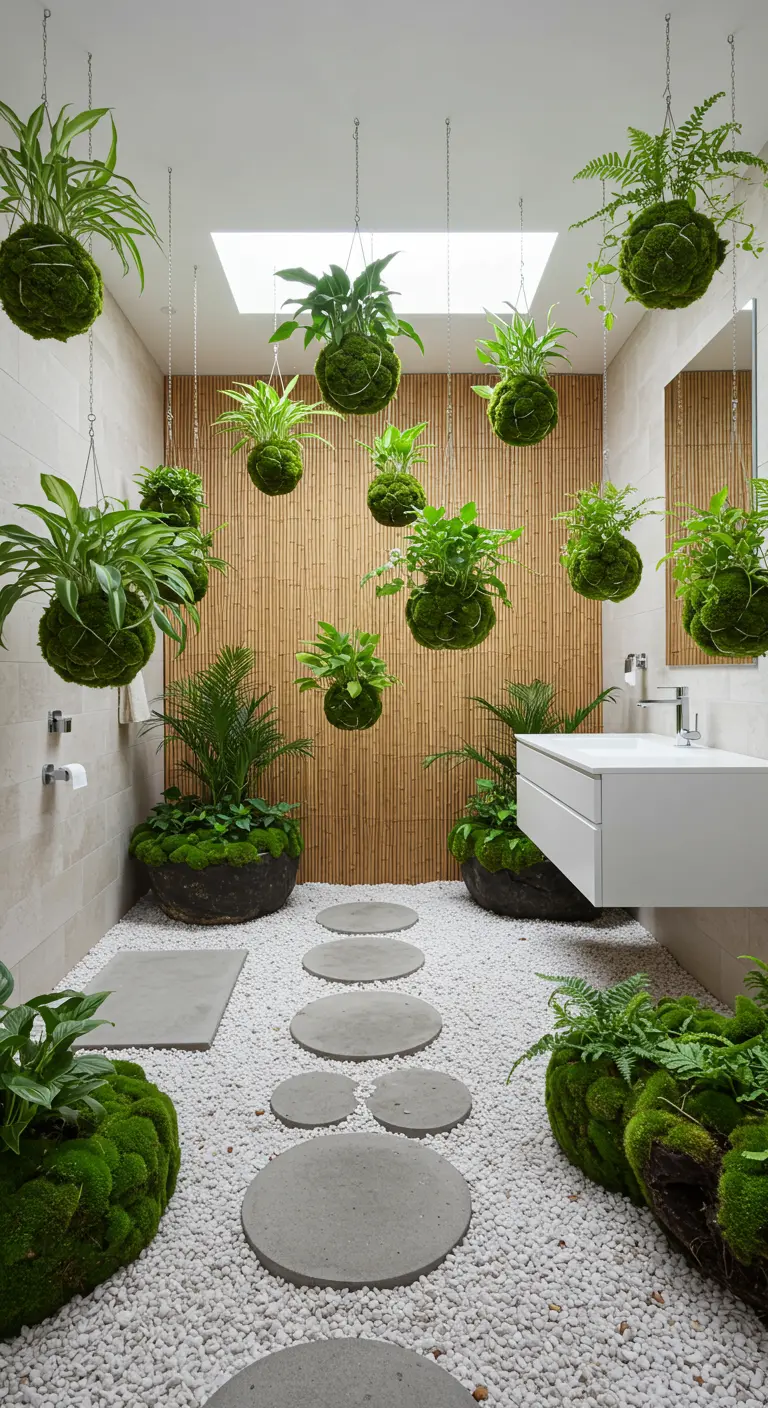
Explore the Japanese art of *kokedama*, or moss ball planting.
Suspending these living sculptures from the ceiling at varying heights creates a magical, floating garden. It’s a whimsical and space-saving way to display a variety of smaller plants.
This approach works especially well over a bed of white pebbles or alongside simple, low-lying moss gardens, as it allows the hanging plants to be the stars of the show.
You can make your own kokedama or purchase them pre-made from many garden centers.
23. Use Plants for Linear Structure
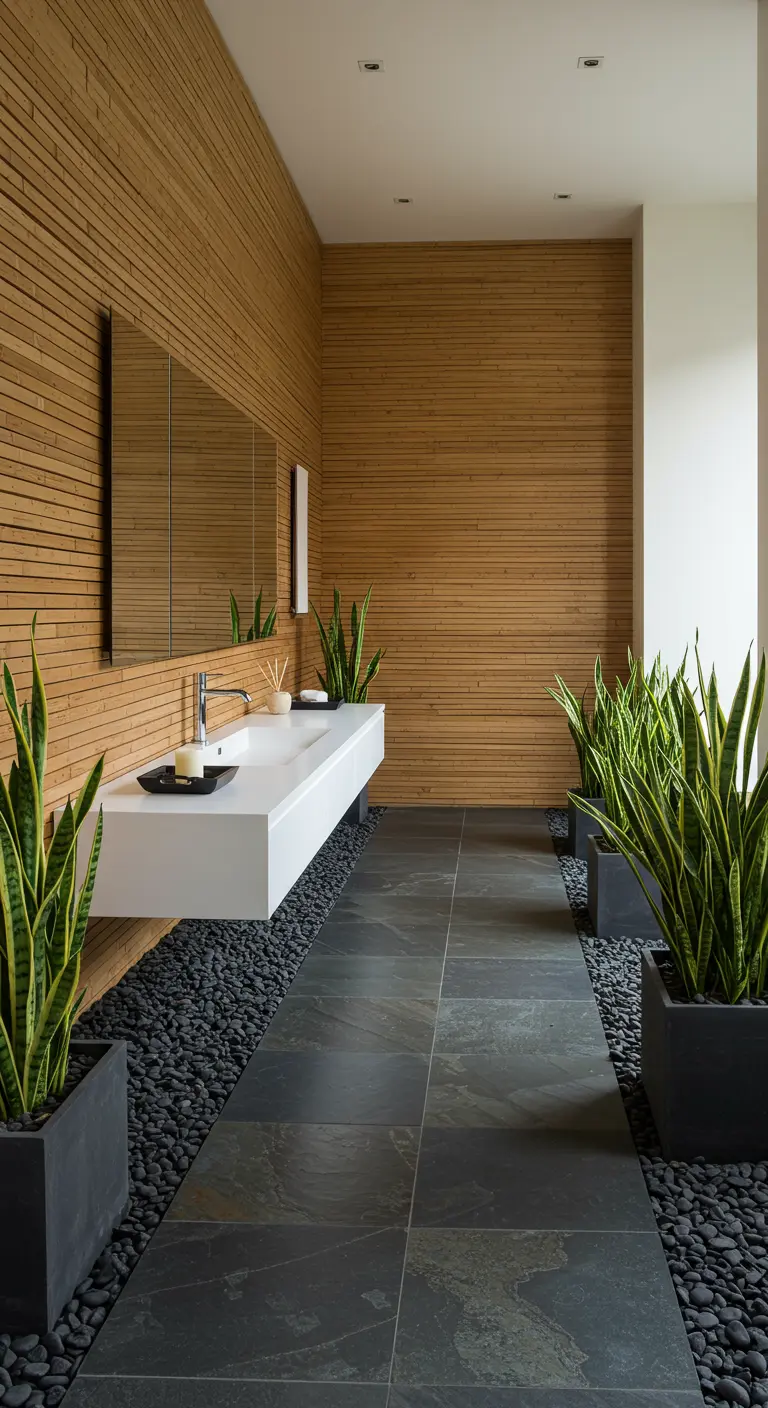
Instead of a meandering path, use plants to reinforce a clean, linear design.
Here, a row of identical snake plants in sleek, rectangular planters lines the edge of the slate tile floor. This repetition creates a strong visual line that guides the eye and feels incredibly orderly and calm.
The border of black river stones between the planters and the tile adds a welcome band of texture, breaking up the hard surfaces.
This is a low-maintenance, high-impact approach that perfectly suits a modern, minimalist aesthetic.
24. Borrow a View from Outside

You don’t need to fit the entire garden inside your bathroom. Sometimes, the best strategy is to frame the view outside.
A floor-to-ceiling glass wall next to a dense bamboo grove makes the exterior landscape the main feature. The interior can remain relatively simple because the view does all the work.
Inside, continue the natural theme with a pebble floor and stone pavers to create a seamless transition. A few simple ferns in the foreground help bridge the gap between the indoor and outdoor greenery.
25. Commit to a True Zen Garden

For the purist, recreate the core elements of a traditional Japanese *karesansui* (dry landscape garden).
Use fine white sand or gravel as the base, carefully raked to represent ripples in water. Place a few large, beautiful stones within the sand to symbolize islands or mountains.
This approach is about minimalism and meditation. The act of raking the sand itself can be a calming ritual. A single, sculpted tree is all the plant life that is needed.
This design requires a dedicated space and a commitment to tranquility and simplicity. It transforms the bathroom into a place for quiet reflection.
26. Create a Steamy, Mossy Grotto
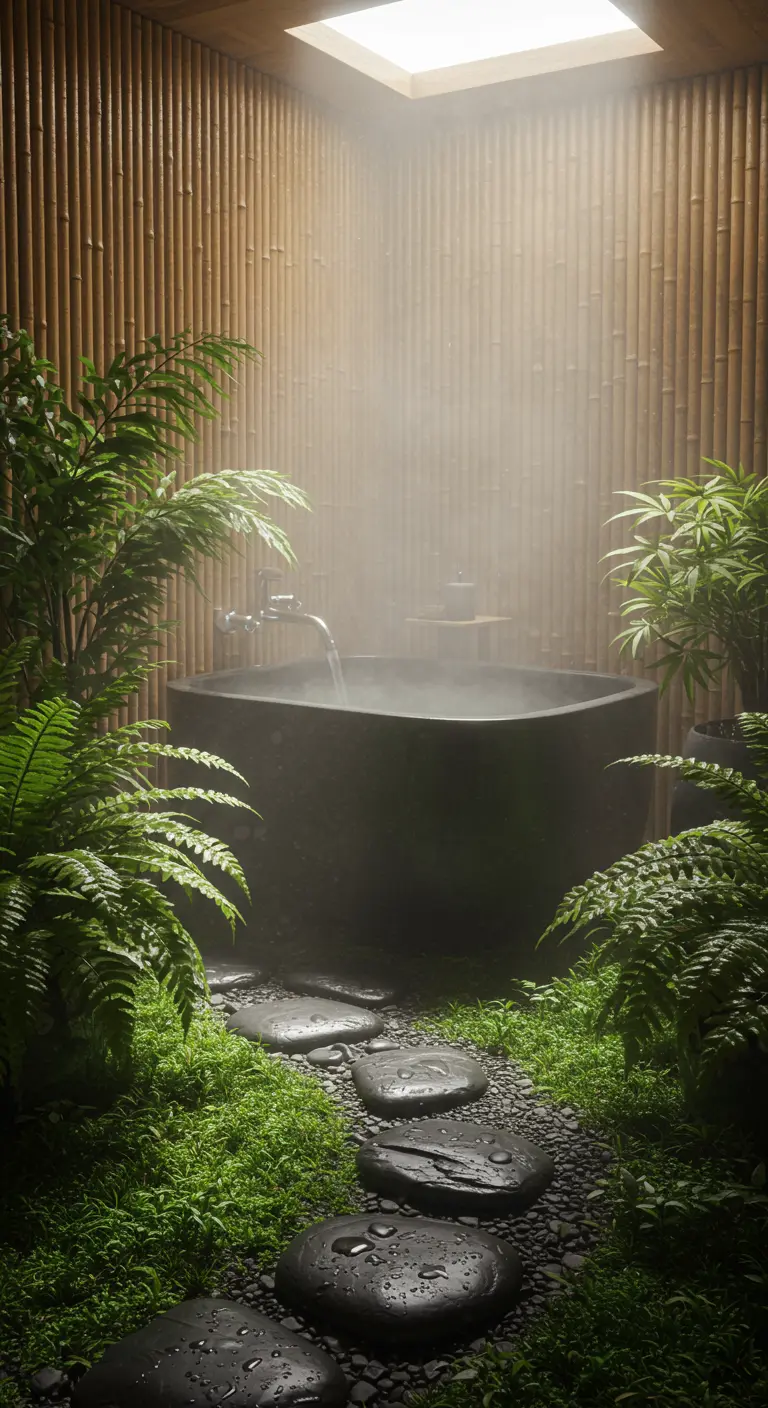
Lean into the humidity of a bathroom to cultivate a lush, moss-covered landscape.
A stone tub, dark irregular pavers, and a bed of rich green moss create the feeling of a hidden forest spring. The steam from a hot bath will keep the moss and ferns vibrant and happy.
A skylight directly overhead can provide the necessary light while adding to the grotto-like atmosphere, as if you’re looking up through a clearing in the trees. This is an ideal environment for moisture-loving plants. It’s like having your own personal tropical oasis.
27. Surround Yourself with Living Walls

For complete immersion, install floor-to-ceiling living walls.
These vertical gardens, filled with a dense mix of ferns and foliage, surround the tub and create the feeling of bathing in the middle of a forest. It’s a powerful statement that fully merges architecture and nature.
A simple path of reclaimed wood planks provides a warm, rustic contrast to the vibrant green. The floating wood vanity with open shelving continues this natural, earthy feel.
Living walls require integrated irrigation systems, but the payoff is a breathtaking, air-purifying environment unlike any other.
